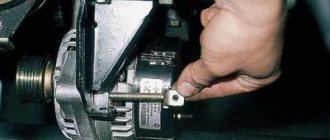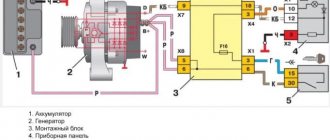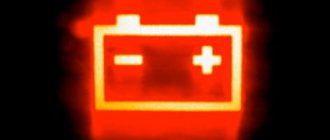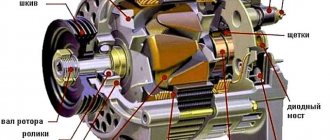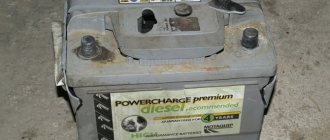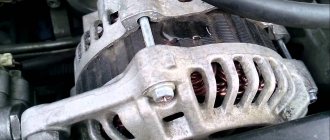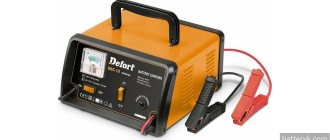An insufficiently charged battery is a common problem faced by many car enthusiasts. If nothing is done in this situation, soon the only solution will be to replace the battery.
It is a mistake to assume that undercharging is associated solely with the end of the battery’s service life or with its defect. Sometimes the fault lies with the motorist himself, who does not comply with operating rules. In addition, the car's generator is a common culprit. And here you need to figure out why the generator may not charge, and how to act in a given situation.
What indicates a problem
It will be useful for the car owner to know what signs can be used to determine that the car’s generator is not charging the battery. This will allow you to detect the problem in a timely manner and take a number of measures to eliminate it.
In the case of modern cars, which are literally overflowing with all kinds of electronics, it is not surprising that there are problems in the electrical system. Even if we are talking about premium segment models.
If a driver is interested in how to understand that his generator is not charging or is not charging the battery well, then several answers can be given here.
The following characteristic symptoms of such problems are identified:
- a light indicating the battery lights up on the dashboard;
- the electrolyte boils away, traces of it appear on the body;
- even after a long trip, the battery still shows a low charge level;
- During the operation of the car, the intensity of the lighting changes;
- Uncharacteristic sounds are observed from the generator.
If you encounter similar symptoms, there is a high probability that the incorrect operation of the car is due to the undercharging of the battery from the installed generator.
Generator performance assessment
If there is a suspicion that the car’s generator is not charging the battery, or is not doing it efficiently enough, then it is recommended to check the unit for functionality. You can do this yourself, without involving third-party specialists in the work.
But here it is quite logical to ask how to independently check the current charging from the generator required for the battery.
It's best to start with indirect signs. Take a look at the dashboard, where there is probably a warning light. If there are no problems in the power supply system, the battery light should not light up. If it is constantly active, then there is a high probability that the battery is not receiving a charge from the generator, or it is very weak.
Of course, such a sign will not give an exact answer. Therefore, it would be more correct to check the generator with a universal multimeter. It will definitely allow you to understand whether the battery is charging or whether there are certain problems in the system.
To do this, you need to connect the probes of the measuring device to the power source, while starting the engine so that the generator runs. If in voltage measurement mode the device shows about 13.6–14.6 V, then everything is fine, the charge is being received. If the device displays about 12 V or even nothing, the battery is not receiving the required charge. You should look for the reasons and eliminate them.
↑ Poor ground connection
The body wire is what connects to the negative terminal of the car battery. An excessively worn or damaged ground wire can make it difficult for electricity to flow to your vehicle's other electrical components. The ECM will detect this discrepancy in electrical flow and then turn on the car battery light in response.
What charge goes from the generator to the battery?
You should also understand the voltage from the generator going to the vehicle battery.
To draw any conclusions regarding performance, you need initial data, indicators that are considered the norm. The primary task is to find out what kind of charge generally should be from the generator to power the battery.
Motorists often make the same common mistake. They replace the battery with a more powerful battery, the parameters of which go beyond those recommended by the automaker. But at the same time, the old generator is left running. The latter, in turn, may simply not cope with the increased load. That is, it does not provide the necessary charging.
Now to the question of how much a standard generator under the hood of a car normally produces to charge the installed battery. The norm is considered to be a voltage of 13.5 to 14.5 V. This is how much the generator transfers to the starter battery so that the latter can replenish its lost charge.
To avoid such undercharging problems, it is better to check the car manufacturer’s recommendations in advance and select components based on these data.
Understanding now what kind of charge the generator should normally provide to the battery, we can give one useful piece of advice. To avoid difficulties starting your car, even in winter, focus on generators capable of delivering a charging current of approximately 10% of the battery capacity. Relatively speaking, if you have a 75 Ah battery under the hood, then the generator should supply 7.5 A. But do not forget that in addition to the battery itself, the generator has a number of consumers that it must also power. And the device should not operate at its maximum capacity. That is, the unit should be purchased with a certain power reserve. The automaker initially calculates this, and therefore the parameters of the factory generator are usually sufficient. It is better to change it if the battery is replaced with a more powerful one, and additional powerful consumers are installed that are not included in the standard configuration of the car.
How to check voltage
Separately, it is worth considering the question of how you can check the current generator voltage on the vehicle battery. Diagnosis is possible in 2 ways. Directly on the generator itself, or through the battery.
For direct communication between the battery and the generating device, a wire with a thick cross-section is used, which allows you to check the potential difference directly on the battery. Here you can use 3 measuring instruments:
- multimeter;
- voltmeter;
- load fork.
The voltmeter and multimeter are connected with probes to the battery. Moreover, in their case, it is not necessary to observe polarity. If a load fork is used, then plus goes to plus, and minus goes strictly to minus. Violating the polarity is strictly prohibited.
The normal mains voltage is considered to be about 12 V. If you turn on the engine at idle speed, but do not turn on electrical appliances, then the norm will be from 13.5 to 14 V. If the voltage drops to 13.3–13.8 V, this is still considered normal.
Using a tester in the form of an ohmmeter or multimeter in resistance measurement mode, you can check the stator, rotor and diode bridge of the generator. When the resistance on the rotor is about 2.3–5.1 Ohms, the equipment is considered to be in good working order. On the winding, the current consumption should be in the range from 3.0 to 4.5 A, and the resistance should be about 0.2 Ohm.
The diode bridge is tested by determining the presence or absence of resistance. Specific numbers don't really matter. It is only important that the resistance does not turn out to be zero.
Do not forget that for normal recharging of the starter battery, a voltage in the range from 13.5 to 14.5 V must be supplied from the generator.
Basic faults
To determine the malfunction, you need to conduct a general diagnosis of the vehicle's electrical system.
It is carried out in order of eliminating possible causes from easily corrected and cheap to complex and expensive. Here is an approximate algorithm on how to check the electrical system of a car.
Frequent short trips
The battery must be replenished every time the engine is started. In city mode with short trips, more energy is consumed than is replenished. The battery should be periodically recharged with a charger. Just keep track of your travel times, especially in winter, and check the condition of your battery more often.
Leakage current
If the car uses more electricity than it replaces, the battery will be discharged. Faulty wiring, breakdowns in electric motor windings, shorted circuit paths are a source of constant energy consumption. A short circuit “drinks” the energy of the battery, which can be completely discharged in a couple of hours.
Current leakage is checked in two ways:
- With the ignition off , remove the terminal from the battery and slowly put it back on. If the terminal “sparks” , there is a reason to check further.
Important! Do not use this method to test cars with an electronic control unit - voltage surges may burn out the ECU capacitors.
- Checking with an ammeter. An ammeter with a measurement amplitude of up to 20 amperes is installed in the gap between the negative terminal of the battery and the ground terminal. The ignition is turned on, if the leak is higher than 0.1 - 0.3 amperes , you need to find unauthorized current consumption.
Finding the cause of current leakage
- the circuits of the electric cooling fan, the generator and the starter in order They usually operate without fuses.
- We turn off the fuses in order when the ignition is on . If the needle on the ammeter drops, we are looking for a short circuit or a damaged consumer in the circuit of this fuse.
- The circuit is “ringed” for the presence of a short circuit in order - from the fuse to the consumer.
Number of amperes from the generator to the battery
Also, many are interested in the question of how many amperes a car generator normally produces for a standard battery. It is important to understand here that the current strength is individual for each electrical system of the machine. It is directly related to how many energy consumers are in the car, and how much is needed for full operation. Additionally, the current must be sufficient to charge the battery.
Amps appear only when a load is formed in the electrical system and the battery is being charged. When the engine was started, the current averaged from 6 to 10 Amperes. But gradually this figure will fall as the process of charging the battery takes place, which takes on the main energy consumption. If you turn on the headlights, audio system, heated seats or mirrors, then the charging current parameters will begin to increase.
Reason #4. The battery does not have enough time to fully charge
The reason is typical for situations where the car is used for short trips, not exceeding tens of kilometers per day. For example, we went to the store, and that’s it – to the garage.
- Firstly, while the car was standing for a long time, the battery was fairly discharged by leakage currents.
- Secondly, you wasted energy from the battery when you started the engine to drive out, and when you left the store (at a minimum).
In total, a certain number of ampere-hours were taken from the battery, which the generator simply did not have time to return during a very short trip.
Why problems occur and how to fix them
It is worth considering separately why the generator does not charge the car battery, and what needs to be done in this or that situation.
This problem cannot be ignored. Even if you have a good charger, you can potentially compensate for the insufficient battery charge using a charger. But in parallel, there may be problems with the generating device itself. And its malfunctions directly affect the operation of the entire electrical system of the vehicle, and not just the battery.
There are several reasons why the car battery is potentially not being charged from the alternator. They may be related to:
- terminals;
- generator belt;
- battery condition;
- overload of the generating device;
- contacts;
- winding;
- mechanical problems;
- fuses;
- diode bridge;
- short circuit
Since the reasons are varied, you need to consider them separately and understand why the generator ultimately does not charge the car battery. Accordingly, recommendations will be presented to eliminate this or that problem.
battery
It would be useful to evaluate the current internal state of the battery, since if the battery is severely worn out, the generator may not be able to do its job fully.
Most often, motorists are faced with sulfation and its negative consequences. When device parts are coated with a layer of lead sulfate, charging is disrupted and battery performance decreases.
If sulfation is slight, you can try to restore the battery using a desulfator and special charger modes. But if sulfation has heavily affected the surfaces of the plates, then the most reasonable solution would be to replace the battery.
Terminals
Also look at the condition of the battery terminals connecting the battery to the generator.
If you notice that the battery light on the dashboard suddenly comes on after driving on a bumpy road, it is possible that the terminal has become loose due to shaking and vibration. She needs to be fixed.
Oxidation and mechanical wear can also affect the quality of terminal connections. Check the condition, wipe, remove traces of oxides. Use sandpaper only as a last resort.
Generator belt
To convert mechanical energy into electrical energy, the generator is connected to the crankshaft through a belt. It is the alternator belt that can cause the problem in question of undercharging the battery.
It happens that the belt tension weakens, or it simply wears out over time. Then not only will the battery not receive enough charge, but also general problems in the electrical system will become obvious and visible.
The condition of the alternator belt should only be checked with the engine turned off. Sometimes a simple belt tightening helps. If the profile wears out, the problem can only be solved by replacing the element.
In more rare cases, the belt slips along the pulley due to oil or other liquid getting on the surface. Therefore, it makes sense to try to remove dirt and dry everything.
Overload problem
There are also slightly different situations when charging still occurs from the generator, but the output voltage is not enough. This indicates that the generator is working, but it is not able to fully compensate for the battery charge.
Most likely, these are the last overloads of the generator, which is due to the installation of additional non-standard equipment on the vehicle. New consumers have appeared in the car, and the current electrical system of the car can no longer cope with such a load. Try disabling the newly installed node. If after this the generator begins to charge the battery normally, then the reason has been determined.
There are 2 options here. The first is to install a higher power generator. But this may entail quite complex work to remake the entire electrical system. The second option is based on the refusal of additional freelance equipment.
The decision is up to the car owner. If your dream was to install powerful acoustics, then there is no choice. You will have to make major changes to the car.
Problems with contacts
Most often, specialists and ordinary car enthusiasts discover poor or weak contact in the car, which is why all the previously described symptoms arise.
Contact failure is usually associated with contamination, oxidation, and the ingress of oil and various technical fluids onto their surfaces.
First, you should try to clean all the contacts using a rag soaked in gasoline. Fine-grained sandpaper should be used extremely carefully and only when absolutely necessary.
If there is severe wear on the elements, then there is no choice. You'll have to change contacts.
Winding
We cannot exclude breaks in the winding, which motorists also sometimes have to deal with.
In such a situation, characteristic symptoms can be observed. The generator will not provide the necessary charging, and at the same time its temperature will begin to rise significantly.
To accurately determine the fault, you can disconnect the end of the excitation winding from the brush and connect it to the generator terminal. Then the multimeter is connected via the battery. If there is a break, the multimeter will show zeros. If this is a test light, it will not light up.
To find a faulty coil, a wire from the battery is connected to each of them in turn. If there is an internal break in the coil, you will have to change it. External integrity violations can be eliminated using a soldering iron.
Short circuit problem
A malfunction such as a generator short circuit can manifest itself in several ways. Namely:
- shorts to the rotor housing;
- short circuit on the stator;
- short circuit of the stator to the housing;
- violation of the plus on the body.
A car enthusiast without the appropriate knowledge is unlikely to be able to cope with this malfunction on his own. Therefore, the right decision would be to seek help from specialized specialists.
Mechanical faults
Mechanical failures cannot be ruled out. They often cause a conflict between the generator and the battery.
Mechanical faults include stretching, belt rupture, broken terminals, broken wires and much more, which can be eliminated by repair or replacement.
Fault on the fuse side
And it also happens that the reason lies on the surface, but for some reason the motorist loses sight of it and carries out complex diagnostic work.
In fact, it would be better to start by looking for reasons in the fuse box. After all, if the fuse is blown, then fixing the problem is potentially very easy. To do this, the old element is removed and a new one is installed in its place.
Only here it should be taken into account that the burning of a fuse may be a consequence of an accidental power surge. If there are problems in the wiring, problems with the generator or battery, then replacing the fuse will not solve the situation. Until the cause of the burnout, if any, is eliminated, each new fuse installed will suffer the same fate.
Diode bridge problems
If the diode bridge of a car generator fails, then it will not be able to charge the battery normally.
It is usually possible to diagnose such a problem by changing the intensity of the headlights as the engine speed increases or decreases. Potentially, an experienced auto electrician can restore the operation of the old diode bridge. But the objectively correct decision in such a situation would be to replace it.
There are many reasons why the battery may not be charged from the generator. Consider the symptoms and rely on your capabilities and knowledge. If in doubt, contact a specialist.
Thank you all for your attention! Subscribe, leave comments and tell your friends about us!
